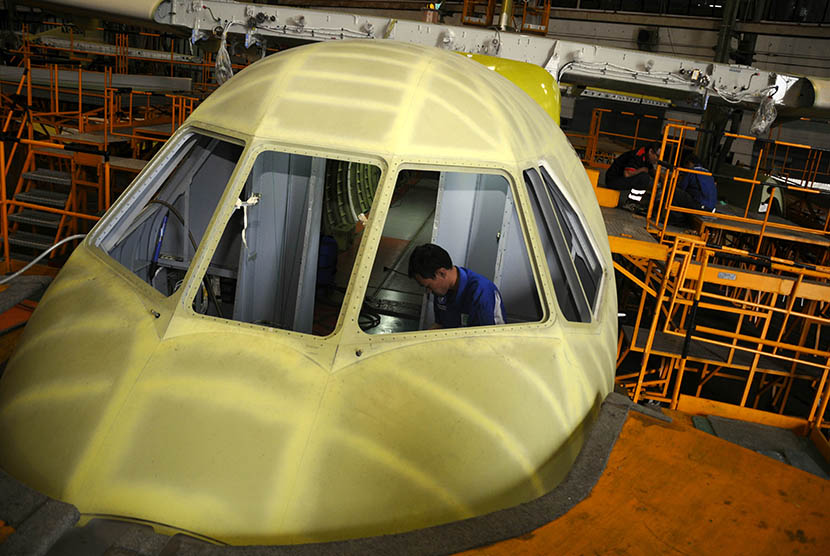CountStrike
FULL MEMBER

- Joined
- Dec 23, 2014
- Messages
- 708
- Reaction score
- 1
- Country
- Location
Indonesia, Iran considering cooperation in development of aircraft industry
Economy
October 1, 2016
Jakarta (ANTARA News) - Indonesia and the Islamic Republic of Iran are studying possibility of cooperation in the development of civil aircraft industry as currently Iran needs to renew a large number of its aircraft for civil aviation service.
The Policy Study and Development Body (BPPK) of the Foreign Ministry said here on Friday, PT Dirgantara Indonesia (PTDI) could study cooperation with the Iran Aircraft Manufacturing Industrial Company (HESA).
The cooperation possibility was an important point in the economic discussion during the visit of an Iranian government delegation to the state-owned aircraft factory PTDI in Bandung on Thursday.
The visit by the Iranian delegation is part of the activities of 5th "Policy Research Consultation" (PRC) of Indonesia-Iran, between BPPK and the Institute for Political and International Studies (IPIS), a think tank of the Iranian Foreign Ministry held by Asia Africa Museum in Bandung.
The Iranian delegates included Iranian Ambassador to Indonesia Valiollah Mohammadi and Vice President of IPIS Rasoul Mousavi.
PRC is an annual activity of BPPK and IPIS to exchange views and information about position and foreign policy of the two countries - bilaterally, regionally and internationally.
BPPK said after the implementation of "Joint Comprehensive Plan of Action" (JCPOA) on 16 January 2016, followed with the lifting of international economic sanction on Iran, that country needs many units of aircraft for civil aviation.
The lifting of the economic sanctions on Iran opened an opportunity for Indonesia to develop closer cooperation with Iran, an oil rich country with a population of 80 million.
Large purchase of aircraft by Iran has been widely reported by international mass media. Iran was reported signing a contract for the purchase of 100 units of Boeing air craft at a price of $17 billion in September 2016, and 118 units of Airbus aircraft valued at $25 billion in January, 2016.
The U.S. finance ministry allowed the purchases by phases.
Iran also is studying purchase of aircraft from the Brazilian aircraft maker Embraer.
Technology and Development Director of PTDI, Andi Alisjahbana, said PTDI, which already has international reputation as an aircraft maker has a big opportunity to sell aircraft to Iran.
Propeller aircraft products of PTDI are suitable for domestic flights, Andi said.
So far, PTDI has exported aircraft to various countries including Brunei Darussalam, Malaysia, Thailand, the Philippines, South Korea, Pakistan, Turkey, the United Arab Emirates, Burkina Faso, Senegal, and Venezuela.
Economy
October 1, 2016
Jakarta (ANTARA News) - Indonesia and the Islamic Republic of Iran are studying possibility of cooperation in the development of civil aircraft industry as currently Iran needs to renew a large number of its aircraft for civil aviation service.
The Policy Study and Development Body (BPPK) of the Foreign Ministry said here on Friday, PT Dirgantara Indonesia (PTDI) could study cooperation with the Iran Aircraft Manufacturing Industrial Company (HESA).
The cooperation possibility was an important point in the economic discussion during the visit of an Iranian government delegation to the state-owned aircraft factory PTDI in Bandung on Thursday.
The visit by the Iranian delegation is part of the activities of 5th "Policy Research Consultation" (PRC) of Indonesia-Iran, between BPPK and the Institute for Political and International Studies (IPIS), a think tank of the Iranian Foreign Ministry held by Asia Africa Museum in Bandung.
The Iranian delegates included Iranian Ambassador to Indonesia Valiollah Mohammadi and Vice President of IPIS Rasoul Mousavi.
PRC is an annual activity of BPPK and IPIS to exchange views and information about position and foreign policy of the two countries - bilaterally, regionally and internationally.
BPPK said after the implementation of "Joint Comprehensive Plan of Action" (JCPOA) on 16 January 2016, followed with the lifting of international economic sanction on Iran, that country needs many units of aircraft for civil aviation.
The lifting of the economic sanctions on Iran opened an opportunity for Indonesia to develop closer cooperation with Iran, an oil rich country with a population of 80 million.
Large purchase of aircraft by Iran has been widely reported by international mass media. Iran was reported signing a contract for the purchase of 100 units of Boeing air craft at a price of $17 billion in September 2016, and 118 units of Airbus aircraft valued at $25 billion in January, 2016.
The U.S. finance ministry allowed the purchases by phases.
Iran also is studying purchase of aircraft from the Brazilian aircraft maker Embraer.
Technology and Development Director of PTDI, Andi Alisjahbana, said PTDI, which already has international reputation as an aircraft maker has a big opportunity to sell aircraft to Iran.
Propeller aircraft products of PTDI are suitable for domestic flights, Andi said.
So far, PTDI has exported aircraft to various countries including Brunei Darussalam, Malaysia, Thailand, the Philippines, South Korea, Pakistan, Turkey, the United Arab Emirates, Burkina Faso, Senegal, and Venezuela.

















